The migration that no one knew about
Sara • 08/09/2023
SHARE
We’re ‘circling’ back to Botswana as we’re talking about an animal migration that no-one really knew about until the mid-2000s. Isn’t that amazing? We thought we everything about animals and their movements yet even David Attenborough hadn’t identified this one yet!
In the 1950s and 60s, Botswana put veterinary fences to fight outbreaks of foot-and-mouth disease in cattle. These fences stretched for hundreds of kilometers, segmenting the country, and blocking the migratory route of zebras. It wasn’t until around 2004 that these fences were removed, and here’s what’s amazing – within three years of the fences being removed, some of the zebra had started to migrate.
It still took almost a decade for wildlife researchers to notice that Botswana’s zebras were making unusual movements through inaccessible parts of the country. Researchers began to realize that the herds appeared to occupy specific regions at specific times of the year – a certain pattern was forming and more research needed to be done.

in 2012, the Worldwide Fund for Nature, Namibia’s Ministry of Environment and Tourism, Elephants Without Borders, and Botswana’s Department of Wildlife and National Parks structured a research exercise whereby GPS collars were placed on eight adult zebras. For 2 years, these 8 zebra were followed and the results confirmed that Botswana’s zebras were completing 2 migratory routes around Botswana!
Dr. Robin Naidoo, a senior conservation scientist at WWF and lead author of the study said: “This unexpected discovery of endurance in an age dominated by humans, where we think we know most everything about the natural world, underscores the importance of continued science and research for conservation.”
The predominantly inaccessible route (to humans) shows that the zebras travel in an almost direct line south from Chobe to Nxai Pan. “The almost unerring north-south direction was unusual. The distance covered by these zebras was a total shock to all of us involved in the study, as well as to people familiar with wildlife conservation in the region. Nobody knew that something of this scale, with this much ground covered, was occurring,” says Naidoo.
The outcome was extraordinary:
The GPS tracking confirmed that Botswana’s zebras were completing a round-trip journey of around 300 miles (482 km) each year. Dr. Robin Naidoo, a senior conservation scientist at WWF and lead author of the study said: “This unexpected discovery of endurance in an age dominated by humans, where we think we know most everything about the natural world, underscores the importance of continued science and research for conservation,”.
Conservation biologist Hattie Bartlam-Brooks from the University of Bristol says, “They had managed to restart a historical migration and within two years were following a highly directed route between their two ranges.” She goes on to say, “Zebra find their way hundreds of miles through relatively featureless, arid scrubland. Pretty amazing when you think they only make that journey twice a year.
There are 2 major migration routes that have been established:
1: Zebras spend the dry season which in the Southern Hemisphere is winter from June – November around the Okavango Delta and the Chobe River floodplain. When the rains begin, usually around the end of November or early December, they move in two distinct groups – one from the south-eastern Okavango Delta to the Makgadikgadi Pan National Park and back.
2: The other Zebras start at the Chobe floodplains and move to Nxai Pan National Park.
For most zebra, the Chobe to Nxai Pan journey covers roughly 155 miles and typically takes 14-20 days. However, some zebras have been documented to take a more circuitous route that can take more than a month and cover up to about 250 miles.

Researchers have ascertained that the zebras migrate because the grasses at the pans have a higher content of protein and minerals than the ones in the Okavango Delta or the Chobe floodplains, providing the zebra with two to three times more nutrition than from the grasses of the Delta. The fresh grass is so rich and nutritious that approximately 30,000 animals will be on the move at any one time.
The Greater Makgadikgadi includes two National Parks, Makgadikgadi Pans National Park, and the smaller, adjacent Nxai Pan National Park.
Located in the Kalahari Desert, these are the world’s largest salt pans – an extraordinary site to behold. An isolated place where the 370 square miles of Okavango Delta finally seep away into the insatiable sands of the Kalahari Desert. In our next post we will share our best places to stay.

